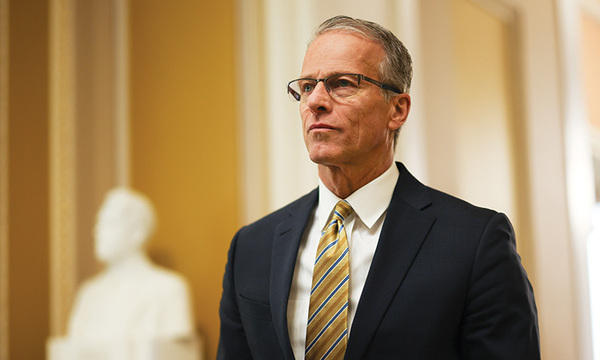If you think most evangelicals are Western, white and know who Rick Warren is, then think again.
The new faces of evangelicalism are brown, black and speak a language other than English.
Evangelicalism is shifting to the global South. Besides being ethnically diverse, the church is seeing a rise in different styles of worship and expression than those found in Western countries.
Stagnant pews in the United Kingdom and United States contrast sharply with the staggering church growth taking place in Africa, Asia and Latin America. In 1900, 80 percent of all Christians lived in Europe and North America, according to the Center for the Study of Global Christianity. In 2005, just 40 percent did.
When American Christians think of the churchâs center of gravity, we may make think of Colorado Springs, home to more than 100 evangelical organizations, such as Focus on the Family. But the churchâs new geographical center is sub-Saharan Africa, home to over 90 million evangelicals.
âItâs the Southern Hemisphereâs turn,â said Richard Starcher (â76), a missions professor at Biola. âThe Holy Spirit is moving in a big way there.â
In Americaâs affluent, post-Enlightenment society, many Christiansâ big concerns include things like attacks on the traditional family and the secularization of the schools. Yet, other parts of the globe still share much in common with the biblical world â agrarian societies and places of political upheaval and persecution.
As a result, these Christiansâ daily lives and concerns are worlds apart from our own. To learn more about their challenges, Biola Magazine spoke with several Biolans whoâve lived and ministered in these places.
One of the stories had to be pulled prior to publication, due to concerns about the danger it could pose to the Christians involved. It was about Christian children in an Asian country who are being kidnapped by Islamic extremists and forced to become suicide bombers.
Here are glimpses into the everyday lives of evangelical Christians in four other regions of the world: Africa, the Middle East, Ukraine and China.
Sub-Saharan Africa: Ethnic Conflict
The U.S. presidential campaign leaves no doubt â American politics can get heated. But in some regions of the world, elections are deadly â as headlines from Kenya show.
Once considered a model African country, a tribal conflict raging there has resulted in a massive wave of house burnings and hundreds of thousands of refugees.
Violent ethnic conflicts are common in sub-Saharan Africa, where Christians are often killed by other professing Christians, according to Faustin Ntamushobora, a doctoral student at Talbot School of Theology and native Rwandan who works to reconcile tribes.
âThey grab machetes or whatever they can find and go and kill their neighbors without any reason â just because someone is not a member of their tribe. Itâs simply barbaric,â Ntamushobora said. He knows firsthand.
Ntamushobora, together with his wife and four children, are survivors of the 1994 genocide in Rwanda when, in just three months, up to 1 million people were massacred.
âWe spent days hidden under the bed, and we fled, and God spared our lives,â he said.
After the genocide, Stan Guthrie, a senior editor at Christianity Today, asked how it was possible for such atrocities to occur in a country that is over 80 percent Christian.
Ntamushobora thinks he knows the answer. Africans are converting to Christianity, but theyâre not being taught how to live it.
âThese people are churchgoers, but theyâre not disciples of Jesus Christ,â he said. âThere is great need for teaching, discipleship and leadership development.â
Christian leaders canât keep pace with the phenomenal growth of Christianity in Africa, according to Starcher, who recently returned from 20 years of ministry there. The lack of teaching has made African Christians vulnerable to cults and harmful sectarian beliefs and practices, Starcher said.
Pastors in Africa sometimes incite conflict by criticizing leaders of other tribes and encouraging violence, according to Ntamushobora.
âIn many places in Africa, what the leader does, the followers do, too. If he says kill them, they will go ahead and kill,â he said.
Yet, a growing number of Christians are speaking out against ethnic conflict, Ntamushobora said. During the first week of January, Christians from all the churches in Limuru, Kenya â a town about 30 miles northwest of Nairobi, the capital â met to pray and seek mutual forgiveness.
And, in July, Ntamushobora will travel to Kenya and Rwanda to train 200 pastors on how to reconcile their tribes, including teaching them skills in trauma counseling and conflict mediation.
Tribal reconciliation is difficult, even for Christians, according to Starcher.
âItâs very hard when thereâs been such violence in both directions and you have whole generations scarred by it,â he said.
Starcher saw the aftermath of the Rwandan genocide up close. He made frequent visits to the refugee camps in Zaire (now the Democratic Republic of Congo) while he was serving as director of the Africa Evangelical Free Church. He said heâll never forget the sight of the camps: Almost as far as the eye could see, there was a sea of blue plastic tarps that the United Nations distributed for shelter.
âThat was home for two years for entire families,â Starcher said.
Ntamushobora said his heart aches over the ethnic wars that are destroying so many lives. But he thinks theyâve contributed to the growth of the African church.
âGod has always used difficult times to grow the faith of believers,â he said.
Gaza (Palestinian Territories):Christians Under Seige
In Gaza tonight, Christians will huddle together in homes â singing, worshipping, encouraging each other.
And tomorrow night. And the next night.
âThey meet together every night,â said Biola alumnus Tom Doyle (â79), 52, a Middle East church planter from Dallas, Texas. âThey are the closest-knit group I have ever met anywhere.â
ÓŁĚŇĘÓĆľ 250 evangelical Christians live in Gaza, in a sea of 1.4 million Muslims, according to Doyle, who makes frequent trips to the Palestinian Territories. Caught in the conflict between Hamas and Israel, the Gazans are cut off from the rest of the world.
âYoung women train themselves to laugh loudly when bombs go off, so their babies wonât be afraid by the big noise,â Doyle said.
On top of this, the Christian leaders receive frequent death threats, he said. And theyâre not idle threats.
Decades of hounding from Islamic extremists has gotten worse since Hamas took over the Gaza Strip in June. One of the Gazan Christiansâ own â Bible Society worker Rami Ayyad â was tortured and killed in October. The 32-year-old Ayyad told friends he sensed he was being followed in the days before he was kidnapped. His body â found lying in the street â had stab and gunshot wounds. He left behind a pregnant wife and two small children.
âIt looks like the murderers are from a terrorist group, so there is no one to go to for help at this time,â Doyle said.
Persecution plagues Christians living throughout the Middle East.
The U.S. Department of Stateâs 2007 Report on International Religious Freedom highlighted abuses in Gaza and the West Bank, Iran, Saudi Arabia, Egypt and Iraq. Churches are bombed frequently in Iraq, and many Christians there have fled to Syria.
After Ayyadâs slaying, the pastor of Gaza Baptist Church â the only official evangelical church â fled to the West Bank along with the Bible Society staff. The remaining Christians have turned to each other for support.
âThey pray into all hours of the night,â Doyle said.
But they donât just pray for their safety. Their No. 1 prayer is for courage to share the gospel, he said.
And share it they do. They bring food donated by overseas ministries to refugee camps and ask Muslims if they can pray for them. Doyle said heâs peeked during these prayers and seen the Muslims staring wide-eyed in amazement at the Christians. Their personal prayers look much different from the Muslim ritual prayers, according to Doyle.
âThe Muslims see that the Christians make a real connection with God,â he said.
In response, the Christians have become sought after for prayer.
And theyâve found that Muslims are becoming more open to Christianity â a phenomenon Doyle is documenting in his forthcoming book, The Crescent Moon Meets the Cross of Christ.
ÓŁĚŇĘÓĆľ 50 percent of Muslim conversions to Christianity follow dreams or visions, according to Doyle. This lends to a charismatic bent, yet Doyle said the faith practices of the Gazan Christians are a blend of denominational traits.
âThey study the Word like Bible churches, they evangelize like Southern Baptists, they worship and pray like charismatics,â he said.
And they donât have the luxury to divide over doctrine. American evangelicals often ask Doyle about the Gazansâ beliefs â like whether their eschatology is premillennial or postmillennial.
âI say, âTheyâre just trying not to get hit by missiles,ââ he said, adding, âItâs amazing how simple your theology gets when you are under persecution. They are one.â
Ukraine: Living Hand to Mouth
Most Americans agree that U.S. health care needs reform. But try to imagine living in a place where it takes a bribe to get treatment and you may have to bring your own surgical gloves and gauze to your operation.
Free health care is guaranteed by the Ukrainian constitution. But, in reality, patients must often bring all their own supplies, according to Mark Saucy, a former missionary to Kyiv (pronounced kee-ev), who now directs Talbot School of Theologyâs extension site there.
âYour family has to bring meals to you in the hospital or you may not get fed,â Saucy said.
Even with treatment there are no guarantees.
âThe doctor could be drunk or utterly incompetent. There are just horror stories,â he said.
Ukrainian citizens enjoy the most religious freedom of all the post-Soviet states, but they face economic hardship. Even the families who live in Kyiv â the capital city â must have multiple sources of income, according to Saucy. A husband and wife who are both working may make 2,579 Hryvnia a month ($500), he said.
With no social safety net â like health care or retirement â itâs hard for Christian leaders to get formal theological training, according to Saucy. Itâs common for students at the extension site to have to drop out of classes when a family member gets sick so they can get another job to pay the medical bills, he said.
Pastor Andrei Zalischuk â a 37-year-old husband and father of two â had to drop out of Talbotâs Kyiv program to seek another job. Besides training to be a professional translator, heâs pastoring a Baptist church of about 45 people.
âChurch is a bivocational thing for me. I donât like that, but this is the reality,â Zalischuk said.
But he was fortunate to complete a bachelorâs degree. For pastors who arenât so fortunate, Zalischuk sets up conferences throughout Ukraine to provide them with non-formal training.
âIt was always my dream to receive theological training. I believed that it would help me to be a more efficient minister to the Lord, and I still stick to this belief,â he said.
The lack of trained pastors is felt by the people in the pews, according to Saucy. New Christians start off gung-ho about their faith, but arenât taught how to grow spiritually. So, many abandon it.
âThe revolving door is very challenging for the church,â Saucy said.
Talbot has filled a dark hole for theological training in Ukraine, he said. Itâs the first seminary to offer Western-accredited theological degrees at the masterâs level.
The Ukrainian pastors who are enrolled at the extension are very grateful for it, according to Saucy. In the non-accredited seminaries and Bible colleges, unqualified people often are allowed to teach simply because they bring the money to fund their own classes, he said.
âThey can teach crazy things that arenât even orthodox or are just based on some guyâs personal soapbox,â Saucy said. âThese people donât have the academic qualifications or knowledge to enrich the students.â
Yet, the Ukrainian Christians approach the study of theology differently than Western Christians, according to Saucy. Western theologians are more rigidly logical, but Ukrainian Christians have an Eastern mentality that embraces mystery, Saucy said. Many Western theologians feel a need to explain the Trinity, but the Ukrainians more readily accept it, he said.
âWe love C.S. Lewis. They donât. Heâs too rational in his Christianity for them,â he said.
As for Zalischuk, he still hopes to complete his masterâs degree one day â when the circumstances of life allow.
âI plan to return, but the answer to the question âwhenâ depends on too many factors,â he said.
China: Under Surveillance
A Chinese house church service has ended, but the Christians donât leave all at once. They intentionally stagger their departures out â leaving individually or two-by-two.
They donât want to draw attention to themselves.
Religious persecution isnât conspicuous in China, like it is in Gaza and other places, according to Bill Parker, 49, a Biola student, part-time professor and former missionary to China for eight and a half years.
When Christians visit China, they often think itâs not as bad as the stories theyâve heard, Parker said.
But the impression you get publicly is quite different from what goes on behind the scenes, said Parker, who asked that we not use his real name.
âThe persecution tends to be hidden,â he said. âChristians suddenly disappear. Nobody knows where they went.â
Because of government eavesdropping, Christians use code words in telephone, e-mail and public conservations, Parker said.
Not that itâs illegal to be a Christian in China. But many ways of practicing Christianity are illegal. All Christians are required to attend registered churches. Evangelism is against the law and so is childrenâs Sunday school. Pastors canât teach about the Second Coming.
Plus, all the pastors are required to give the teachings of Bishop Ding, the leader of the official church, whose Christianity is very liberal and political, according to Parker.
âA lot of Christians find the registered churches to be too confining to the full exercise of their faith,â he said. âThey feel that if they are truly going to be Bible-believing Christians, then they have to go to a house church.â
Though illegal, house churches account for the explosive church growth that has occurred in China, and many house churches are part of underground networks of several hundred churches. Some regional authorities turn a blind eye to the house churches, but not all authorities.
To keep from getting caught at a house church, the Christians have to be extra cautious, according to Ann Lee, a Chinese Talbot student who has been part of two house churches in northern China. (She also asked us to use a pseudonym for her since she will return to China.) One of the house churches she attended rented rooms on the upper floors of apartment buildings so the other tenants wouldnât hear the noise from their worship, said Lee.
House churches rarely have more than 30 members. And the Christians have to be very careful about who they invite to church. They canât risk getting turned in to the police.
âIf we feel a person is interested in Christianity and is safe, then weâll invite them to church,â Lee said. âItâs hard because you want people to be saved, but at the same time you want to protect yourself.â
Parker and his wife returned to the United States two and a half years ago, but he still finds it hard to pray in a restaurant. He forgets that he doesnât have to hide his faith.
Parker said heâs grateful for the freedom he has in America, but he believes persecution has its blessings.
âWhere the church is restricted, that is where the real growth is happening â and the faith is deep and genuine,â he said.
Learning From Each Other
Western Christians are just now getting to know their brothers and sisters in other parts of the world. But Saucy said the comfortable lives we lead make us naive about what most Christiansâ lives are like.
âIt would help us to look at their lives and see how our affluence has blinded us to some aspects of Godâs heart,â Saucy said. âJust because theyâre poorer doesnât mean theyâre not as smart. They have an experiential relationship with God that we can benefit from.â
 Biola University
Biola University



